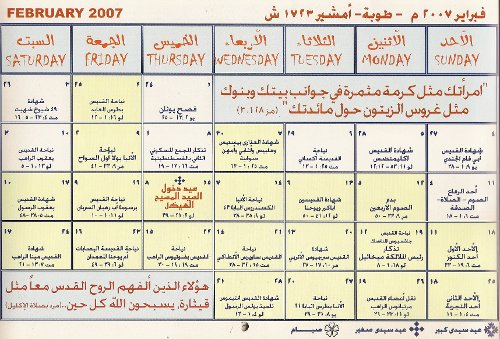Counting years

The current year is:
Anno Domini
How does one count years?
In about AD 523, the papal chancellor, Bonifatius, asked a monk by the name of Dionysius Exiguus to devise a way to implement the rules from the Council of Nicaea (the so-called “Alexandrine Rules”) for general use.

This is a page from an Egyptian Christian calendar. The Coptic church still uses the Diocletian era (a.k.a the Era of Martyrs). In the top right corner, two Arabic numbers can be seen:
 = 2007 (after Christ).
= 2007 (after Christ). = 1723 (after Diocletian).
= 1723 (after Diocletian).
Dionysius Exiguus (in English known as Denis the Little) was a monk from Scythia, he was a canon in the Roman Curia, and his assignment was to prepare calculations of the dates of Easter. At that time it was customary to count years since the reign of emperor Diocletian; but in his calculations Dionysius chose to number the years since the birth of Christ, rather than honour the persecutor Diocletian.
Dionysius (wrongly) fixed Jesus’ birth with respect to Diocletian’s reign in such a manner that it falls on 25 December 753 AUC (ab urbe condita, i.e. since the founding of Rome), thus making the current era start with AD 1 on 1 January 754 AUC.
How Dionysius established the year of Christ’s birth is not known (see below for a couple of theories). Jesus was born under the reign of King Herod the Great, who died in 750 AUC, which means that Jesus could have been born no later than that year. Dionysius’ calculations were disputed at a very early stage.
When people started dating years before 754 AUC using the term “Before Christ”, they let the year 1 BC immediately precede AD 1 with no intervening year zero.
Note, however, that astronomers frequently use another way of numbering the years BC. Instead of 1 BC they use 0, instead of 2 BC they use -1, instead of 3 BC they use -2, etc.
The earliest uses of BC dating are found in the works of the Venerable Bede (673-735).
In this section I have used AD 1 = 754 AUC. This is the most likely equivalence between the two systems. However, some authorities state that AD 1 = 753 AUC or 755 AUC. This confusion is not a modern one, it appears that even the Romans were in some doubt about how to count the years since the founding of Rome.
How did Dionysius date Christ’s birth?
There are quite a few theories about this. And many of the theories are presented as if they were indisputable historical fact.
Here are two theories that I personally consider likely:
- According to the Gospel of Luke (3:1 & 3:23) Jesus was “about thirty years old” shortly after “the fifteenth year of the reign of Tiberius Caesar”. Tiberius became emperor in AD 14. If you combine these numbers you reach a birthyear for Jesus that is strikingly close to the beginning of our year reckoning. This may have been the basis for Dionysius’ calculations.
- Dionysius’ original task was to calculate an Easter table. In the Julian calendar, the dates for Easter repeat every 532 years. The first year in Dionysius’ Easter tables is AD 532. Is it a coincidence that the number 532 appears twice here? Or did Dionysius perhaps fix Jesus’ birthyear so that his own Easter tables would start exactly at the beginning of the second Easter cycle after Jesus’ birth?
Was Jesus born in the year 0?
No.
There are two reasons for this:
- There is no year 0.
- Jesus was born before 4 BC.
The concept of a year “zero” is a modern myth (but a very popular one). In our calendar, AD 1 follows immediately after 1 BC with no intervening year zero. So a person who was born in 10 BC and died in AD 10, would have died at the age of 19, not 20.
Furthermore, as described above, our year reckoning was established by Dionysius Exiguus in the 6th century. Dionysius let the year AD 1 start one week after what he believed to be Jesus’ birthday. But Dionysius’ calculations were wrong. The Gospel of Matthew tells us that Jesus was born under the reign of King Herod the Great, who died in 4 BC. It is likely that Jesus was actually born around 7 BC. The date of his birth is unknown; it may or may not be 25 December.
When did the 3rd millennium start?
The first millennium started in AD 1, so the millennia are counted in this manner:
| 1st millennium: | 1-1000 |
| 2nd millennium: | 1001-2000 |
| 3rd millennium: | 2001-3000 |
Thus, the 3rd millennium and, similarly, the 21st century started on 1 Jan 2001.
This is the cause of some heated debate, especially since some dictionaries and encyclopaedias say that a century starts in years that end in 00. Furthermore, the change 1999/2000 is obviously much more spectacular than the change 2000/2001.
Let me propose a few compromises:
Any 100-year period is a century. Therefore the period from 23 June 2004 to 22 June 2104 is a century. So please feel free to celebrate the start of a century any day you like!
Although the 20th century started in 1901, the 1900s started in 1900. Similarly, the 21st century started in 2001, but the 2000s started in 2000.
What do AD, BC, CE, and BCE stand for?
Years before the birth of Christ are in English traditionally identified using the abbreviation BC (“Before Christ”).
Years after the birth of Christ are traditionally identified using the Latin abbreviation AD (“Anno Domini”, that is, “In the Year of the Lord”).
Some people, who want to avoid the reference to Christ that is implied in these terms, prefer the abbreviations BCE (“Before the Common Era” or “Before the Christian Era”) and CE (“Common Era” or “Christian Era”).







